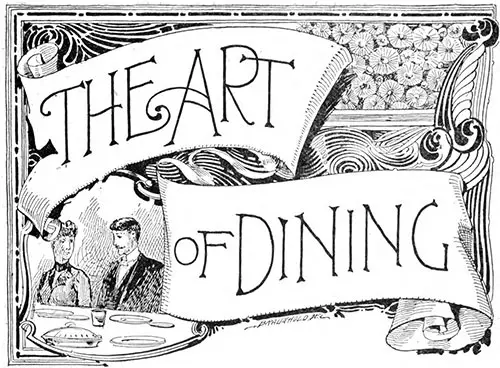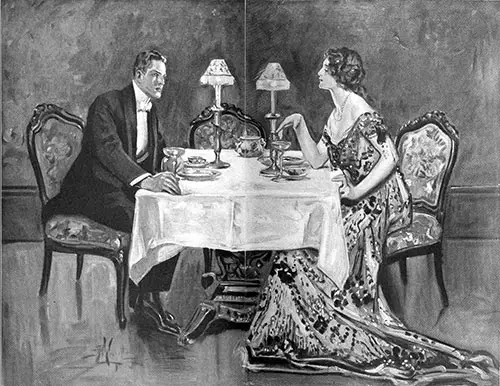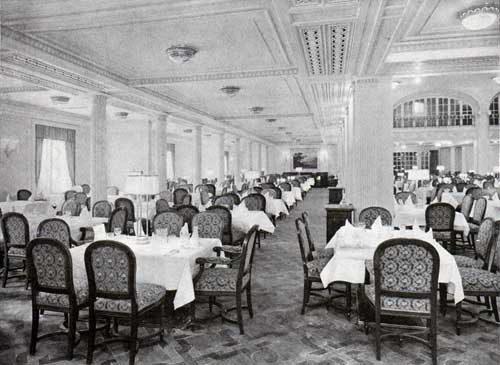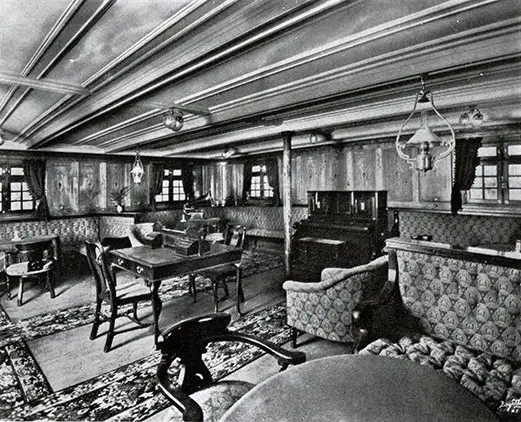Epicurus and the Fine Art of Dining: Philosophy, Pleasure, and the Culture of Dining in 1908

🍷 Review and Educational Relevance
Introduction
The 1908 article “Epicurus – The Fine Art of Dining” explores how London’s Gaiety Restaurant embodied the Epicurean ideal of balancing pleasure, intellect, and social harmony at the dining table. Far more than just an advertisement for a fashionable restaurant, the article ties philosophy, culinary culture, and social life together—making it especially relevant when studied alongside the culture of ocean travel dining saloons of the same era.
Epicurus, often misrepresented as a patron of indulgence, is here reframed as a philosopher of balance—where dining is about more than appetite: it is a ritual of hospitality, intellectual exchange, and sensory refinement. This perspective has striking parallels to the luxury liners’ dining rooms, where food, music, and design transformed meals into a social performance at sea.
No philosopher in the history of the world has been so widely misunderstood as Epicurus. The actions of persons ignorantly proclaiming themselves to be his followers have repeatedly confused the name of Epicurus with proceedings and doctrines which he would, so far from advocating, have openly disavowed.
Things have been done in his name, institutions and schemes originated, which have no more direct connection with Epicurus than has the late Queen Anne with the doings and writings of Mr. George Bernard Shaw.
One, therefore, hesitates to employ his name as an epithet descriptive of the character of any modern place or people. These can seldom be justly described as Epicurean.
But occasionally the case arises when something appears so self-evidently Epicurean in construction and design that the old philosopher’s name is forced from one’s lips as the only exact and illuminative word to describe its true inner character.
It can be confidently stated that the new Gaiety Restaurant in the Strand presents such a unique case. Scholars and artists might shy away from associating a contemporary restaurant with the philosophy of Epicurus. However, those who view life and literature with a more rational and comprehensive perspective will appreciate that the entire concept of the new Gaiety embodies the Epicurean ideal. It is an actual shrine to Epicurus, a place where one can achieve complete self-realization in the enjoyment of the perfect moment.
“Where shall we dine?” is a question that must, again and again, arise to puzzle both the visitor to London and the resident therein. In this significant capital of ours, there are plenty of places where the hungry mortal can eat to satisfy the physical cravings of hunger. But to truly dine, to experience the pleasure and enjoyment of food and company, one must seek out unique establishments like the Gaiety Restaurant.

Couple Having Dinner. Good Housekeeping, July 1912. | GGA Image ID # 22e8b339af
Dining is a fine art, of which the mere satisfying of appetite is an important part indeed, but one that is far from being the whole. For dinner, as De Quincey has well observed, is not only the principal meal of the day, and therefore the meal of hospitality, but it also involves “the spirit of festal joy and elegant enjoyment, of anxiety laid aside, and of honorable social pleasure put on like a marriage garment.”
Moreover, again to quote the same author, we, like the Romans, have discovered that the true purpose of dinner is to throw the grace of intellectual enjoyment over an animal necessity, and to relieve and to meet by a benign antagonism the toil of brain incident to high forms of social life.
The Question Answered
Now, it will be clear why the question in the above paragraph is not so readily answered as the unthinking might at first suppose; or, rather, could not be so readily answered but a short time back. But now the answer is relatively easy.
At the Gaiety Restaurant in the Strand, the physical, intellectual, and aesthetic requirements of the authentic diner are catered for with fine skill and appreciative sympathy.
This famous house has recently been placed under the management of Messrs. J. Lyons and Co. Their name is a household word for excellence in catering wherever English is spoken. Messrs. Lyons realizing to the full, as Lecky so admirably puts it in his “History of European Morals,” that “Increased cultivation almost always produces a fastidiousness which renders necessary the increased elaboration of our pleasures,” have caused the Gaiety Restaurant to be redecorated and refurbished, and introduced such changes as are calculated to make it not only the most beautiful, but the most comfortable restaurant in town.

View of One Side of the First Class Dining Saloon on the White Star Line Majestic, 1922. | GGA Image ID # 22e89ba357
Concert of Fine Music
Every evening during dinner at the Gaiety Restaurant, the sweetest of music is discoursed. Instrumental selections are varied by vocal items, rendered by vocalists of the highest merit.
For the civilized man, his meal must be such as will please his palate, be easy of digestion, and thereby perform its function of maintaining his bodily strength.
But this is not everything. His higher instincts must be gratified. And nowhere can this ideal be more amply realized than in this restaurant, in a noble apartment, a temple to the aesthetic.
So bright, so beautiful is the place that one is constrained to exclaim: “All is daintiness, elegance, repose.” Whilst evening dress is optional, the ladies of the family, for whom dining out has a very social attraction, will be happy to learn that the scheme of decoration and coloring has been adopted with an eye to its not impairing the charm of their toilettes, to which, indeed, it forms a most harmonious background.
The Grill Room
Immediately below the restaurant is the grill room. It now has its cloakroom and is entered through a pleasant lounge, where members of a party can wait for one another in comfortable ease.
White is the prevailing color of the walls here, with a green and gold frieze; the lighting has been rearranged and increased, and now, a brighter and more cheerful grill room is to be found. Here, good old English fare prevails.
Chops and steaks and the Primest of joints, roasted to a turn in open fires, are served. Any guest wishing to see this fine old English cooking in actual operation is invited to visit the roasting kitchen.
The grill room prices have been rectified and reduced so that they are now on that moderate scale which has become associated with the name of Lyons.

Ladies Saloon and Music Room 1920s. Baltic-America Line, Fleet and Services, 1920s. | GGA Image ID # 22e89ad10f
An orchestra has been installed here and plays a well-selected programme throughout the day. In addition to these strikingly handsome public rooms, the Gaiety is remarkable for the number, variety, and elegance of its private rooms for parties and its banqueting halls.
For larger parties and public banquets, the stately Georgian Hall is unrivaled. It will comfortably accommodate 250 guests. It is of the exact dimensions as the restaurant. It looks lovely in its new decoration of cream and old gold. It has a spring floor and is convertible into a perfect ballroom.
Filled with “fair women and brave men,” this apartment, with its tasteful electric lighting scheme, provides a spectacle of rare beauty. At the same time, the sitting-out facilities are worthy of those afforded for dancing.
The Home Atmosphere
But throughout the entire establishment the one controlling idea that governs the conception of the new restaurant, and the actual realization of that conception in the daily routine and the general arrangements of work and order, is the idea of family life.
In so many sumptuous and fashionable restaurants and even hotels, the atmosphere of home life is dissipated. The visitor is somehow made to uncomfortably realizing that he is but a traveler; that his sojourn at the place where he is dining is but momentary; that he is practically entertained on sufferance, and only tolerated for the fact that he is expected to discharge his bill. It is this feeling of estrangement that has for so long kept the average British citizen, whose ideal of comfort is the ideal of home, out of the public restaurants.
But in the New Gaiety, he will find that the one anxiety of the management has been to preserve the home atmosphere and to cater for family life and family parties before considering any other interest.
To conclude
Here is an establishment which, whether for its appointments or its cooking, needs fear no comparison either at home or abroad; one that worthily upholds the claims of London to be not only the heart of the political and commercial world but to rank first also among the world's pleasure cities.
And when in the fullness of time a new Buckle shall arise to philosophize upon the growth of our latter-day civilization, he will assuredly dwell upon the change that has come over us in the matter of dining. And, summing up in a sentence that complex evolution, he will write: "The English used to feed; now, they dine."
Key Themes
1. Epicureanism Misunderstood
Epicurus is defended against charges of gluttony or excess.
His philosophy is presented as moderation, refinement, and the enjoyment of life’s simple but perfected pleasures.
2. The Gaiety as an Epicurean Temple
The Gaiety Restaurant in London is likened to a modern-day shrine to Epicurus.
Its décor, cuisine, and music created a setting that merged aesthetic beauty with culinary skill.
For students, this offers a lens to understand how public dining spaces reflected broader cultural values.
3. Dining as a Fine Art
The article stresses that to dine is not merely to eat, but to experience food as part of social and intellectual life.
Quoting De Quincey, it frames dinner as “the spirit of festal joy and elegant enjoyment.”
This mirrors the White Star Line and Cunard dining salons, where meals were staged as refined rituals of modern life.
4. Music, Atmosphere, and Sociality
Evening orchestras and refined surroundings elevated the act of dining into a multi-sensory experience.
The emphasis on family atmosphere and “home-like comfort” anticipates the same marketing used by shipping lines promoting tourist class dining—luxurious yet welcoming.
5. The Grill Room Tradition
With hearty English fare like chops and joints roasted over open fires, the Grill Room maintained tradition even within an epicurean setting.
This balance of innovation and tradition also echoes shipboard dining, which offered both formal banquets and casual fare for travelers of different classes.
Relevance to Ocean Travel
Dining Saloons on Steamships were deliberately designed as epicurean spaces—grand halls with orchestras, elegant décor, and elaborate menus.
Just as the Gaiety Restaurant offered Londoners a taste of refinement, ocean liners offered travelers the fine art of dining at sea.
Genealogists and historians studying passenger experiences can see how these dining ideals shaped social class distinctions and cultural expectations during travel.
Noteworthy Images
🖼 Couple Having Dinner (Good Housekeeping, 1912) – A visual of dining as both social and intimate.
🖼 First Class Dining Saloon on the Majestic (1922) – Shows the parallel between land-based epicurean dining and the grand shipboard experience.
🖼 Ladies Saloon and Music Room (1920s) – Emphasizes the role of décor, comfort, and music in dining culture.
These images bridge the philosophical ideals of Epicurus with the material reality of travel dining rooms, making them excellent teaching aids.
Educational Value for Teachers and Students
Philosophy: How Epicurean ideals shaped modern leisure.
History: How restaurants and ocean liners reflected social class and cultural values.
Genealogy: Passenger dining experiences offer insight into the daily lives of ancestors who traveled by sea.
Interdisciplinary Learning: Connects philosophy, literature, architecture, and social history.
Encourage students to use GG Archives materials to compare dining contracts, menus, and passenger accounts when writing essays on social life aboard ships.
Final Thoughts ✨
The 1908 Gaiety Restaurant was not just a fashionable dining spot—it was a cultural performance space embodying Epicurean ideals of beauty, balance, and pleasure. When read alongside the history of ocean liner dining saloons, it reveals how both land and sea dining spaces were transformed into shrines of social refinement.
➡️ For teachers and students: Use this article to frame discussions on how dining became a fine art in both philosophy and practice, linking ancient thought with the modern travel experience.
"The Epicurean Temple - An Innovation: The Fine Art of Dining," in T.P.'s Weekly, London: Hodder & Stoughton, Vol. XII, No. 314, Friday, 13 November 1908, p. 605.
